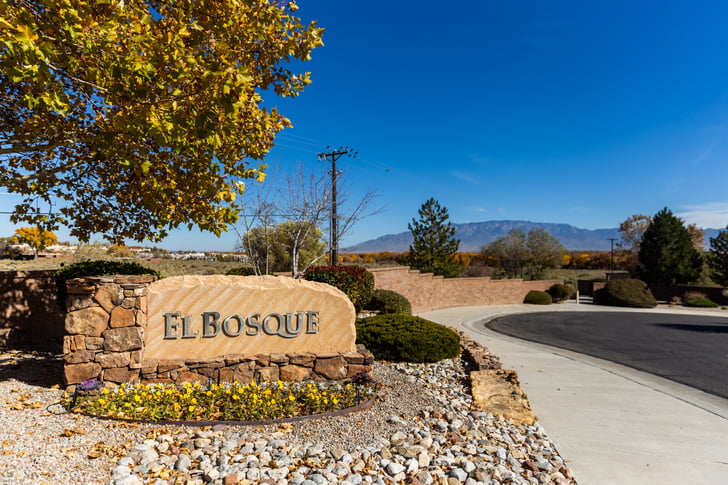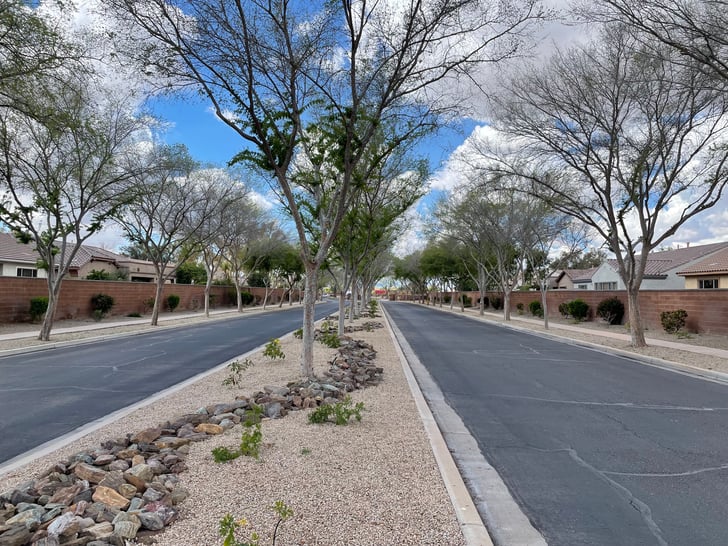When you hear terms like “right plant, right place” or “sustainable landscaping” what’s the first image that comes to mind? The first thing many people probably imagine is a prairie-like scene with tall grasses and pollinator gardens, all lacking color, style, and creativity. Those images may’ve been true twenty years ago, but today most landscaping professionals have adapted and upgraded the terms to include equally sustainable and visually appealing designs.
Today, more property owners (including some of the most exclusive properties in the country) have come to realize that the many myths that existed about the classic landscape design mentality mentioned above are no longer true. That realization has provided exciting opportunities and expanded plant choices to make commercial landscapes pop with variety and creativity.
At the same time, this concept of sustainable landscaping that excites the visitor is relieving budget constraints by dramatically reducing the need for resources that “prop up” plants that aren’t a good fit for certain places
Understanding "Right Plant, Right Place"
In case you’re new to the phrase, “right plant, right place,” landscaping aims to select ideal plants for the environment where they’re installed without the need to excessively alter the nutrients in the ground around plants or irrigate the area in an unnatural rainfall pattern for the area. These plants should also meet the functionality requirements of the property owner.
Key elements of Right Plant, Right Place:
- Evaluating soil type, moisture, sunlight, and wind exposure
- Matching aesthetic value with functional value
- Considering bloom color, leaf textures, and seasonal features
- Cost savings through reduced water use and fertilizer requirements
- Low upkeep means fewer maintenance visits by the landscaper
- Innovative design options that set properties apart
- Extended tree, shrub, and flower lifespan
- Flexibility and adaptation to change
We believe nature is a beautiful thing, and a picture is worth a thousand words, as you can see in the photos below. Mariner’s Watch, near Charleston, South Carolina, is a Yellowstone Landscape project that highlights how attractive a modern, sustainable, native landscape can be.
The Role Of Land-Grant Universities
But you don’t have to be a professional Horticulturist to incorporate sustainability into your landscape’s plant palette. Fortunately, Land-Grant Universities have made education about modern landscaping opportunities available to everyone through their Cooperative Extension Services.
The Morrill Act of 1862 granted federal lands to states so they could establish colleges focused on agriculture and the mechanical arts. The result is nationwide rural and urban access to educational programs and gardening, farming, pest management, and natural resource conservation assistance.
Extensions have massive and insightful data that guide landscaping design decisions based on local climate, soil types, and evolving weather patterns. If you’ve not spoken with your local extension agent, you’re in for a treat. These professionals are as excited to talk about your commercial and home landscaping as you are!
Environmental Responsibility Versus Aesthetic Appeal
We get it. No commercial property owner wants to risk residents, guests, or customers thinking their landscape has no “pop” to it. However, that fear is mostly due to lingering ideas from the early years of what was thought of as sustainable landscaping.
To prove that point further, let’s look at creative design concepts that property managers might miss out on when locked into one type of landscape.
The University of Florida Extension recommends sourcing plants that offer the ultimate in aesthetics while being easy to grow and maintain. These plants could have unique features, textures, or the often-forgotten ability to lure in desirable wildlife that people enjoy watching. These desirables include:
- Luna moth
- Lady bugs
- Costa's hummingbird
Add the Eastern bluebird to those three—with a relevant point.
This bluebird species has suffered population declines due to several environmental factors, including pesticides. It’s worth considering that this beneficial species’ situation can be improved while adding to curb appeal through sustainable plant options requiring fewer pesticides.
On a human level, all we need to do is look at the disturbing water quality situations in a couple of U.S. cities recently. How long before we see eco-friendly properties as the ultimate curb appeal - because they protect their family, friends, and neighbors?
*Studies of major rivers and streams find that 90% of fish, 100% of surface water samples, and 41% of major aquifers contain one or more pesticides at detectable levels.
Leading By Example: The Adoption By High-End HOAs
It’s pretty interesting to watch “keeping up with the Jones’s annual display” evolve into “keeping up with the Jones’s sustainability report.” We noted one client community that made a fine point about this notion earlier. Every plant in that exclusive HOA is a native plant. Those aesthetics don’t take a backseat to any property.
The homeowners and guests there are surrounded by attractive landscaping elements that are not straining local resources or causing overuse of pesticides. Plus, they enjoy enhanced biodiversity and reduced need for maintenance, which is a big relief for today’s budgets.
But we know that the natural aesthetic isn’t yet for everyone. Examples of the traditional “resort style” include our Super Bowl city landscaping projects, where the setting is more temporary, and the desire to add flash is desired. Still, even in those situations, an eco-minded plan is part of the equation.
The bottom line is that most commercial properties are going to see more benefits, with equal aesthetics, from sustainable landscapes than those that require heavier additional resources and maintenance.

Practical Tips For Implementation
While switching gears on a commercial landscape goal may seem daunting, it doesn’t have to be all or nothing. Why not begin with a small section of your property? This can keep you from being overwhelmed with plant choices.
Ironically, being overwhelmed with sustainable, attractive choices is now the reality!
Other steps to guide you on implementing the “right plant, right place” concept:
- Consider the time, labor, and resources available for maintaining the landscape
- Avoid high-maintenance exotic plants (or research alternatives with similar features)
- Favor disease-resistant plants
- Consider plants that repel harmful wildlife
Small-scale projects and those considerations clear your path to seeing impact. Then, assess the results to determine if you want to expand this philosophy to more of your commercial landscaping.
Don’t hesitate to contact us for regional plant choices that fit your landscape. If we don’t have a local branch in your area, contact your local Extension Office. You’ll be greeted by friendly, knowledgeable people on the cutting edge of horticulture who are eager to assist you with fresh ideas and budget-friendly landscaping plans.
Conclusion: “Right Plant, Right Place” Concept
Some may see today’s commercial landscaping sustainability challenges as something to dread. We feel the opposite is true because we have a huge opportunity to be good stewards of this amazing planet. Positive change is within the control of landscaping professionals working alongside property owners and managers.
By investing in creative, sustainable solutions, the “right plant, right place” mentality will help ensure the following results:
- Reduced landscaping costs for property owners
- Cleaner water for our communities
- Visual and eco-friendly curb appeal
- Horticulture knowledge spreading via Cooperative Extension Services
- Enhanced functionality of landscape elements
- Property value increases for owners who invest in attractive, low-maintenance landscapes
Just remember, you’re not alone. The resources available to create these positive changes are enormous and readily available.
We’d love to hear about your plans to incorporate the “right plant, right place” philosophy - so get in touch with us today.



